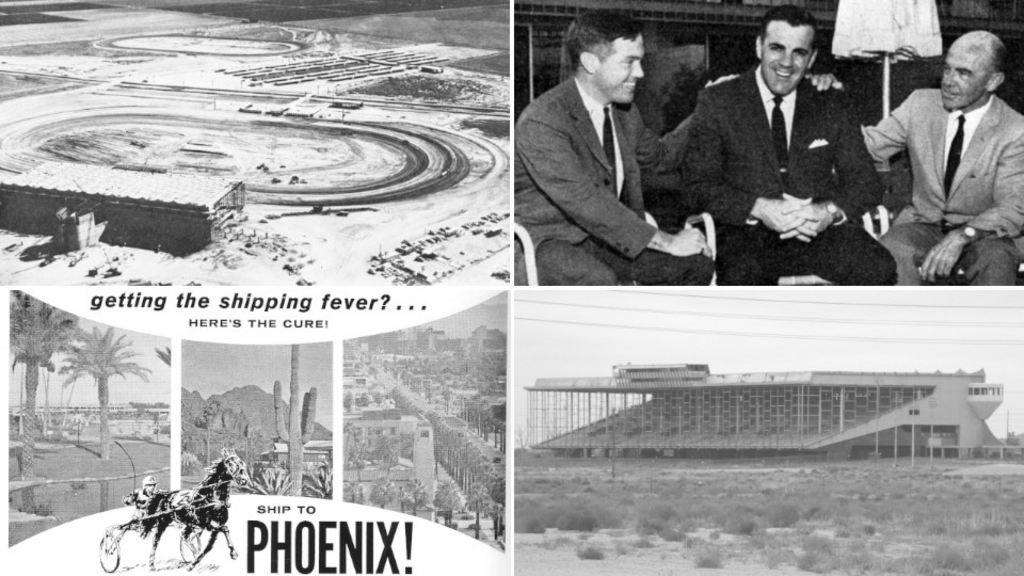
This week's Rewind recalls the rise and fall of The Phoenix Trotting Park, a racetrack built back in the mid 1960's. In this piece Robert Smith recalls this much heralded track's very short history. Despite its rather short existence many photographs exist to chronicle the building and start up of this unique facility.
The decade of the 1960's witnessed a building boom involving race tracks the likes of which had never seen before in the sport of harness racing. As an example, the Province of Ontario saw a total of four brand new tracks constructed between 1962 and 1965 and another retrofitted and modernized for night-time racing; the latter being Western Fair in London (1961). The appetite for harness racing was experiencing new heights and people willing to design and build new tracks was more than meeting the demand. In the U.S. the needs of the times had been somewhat satisfied as they had the luxury of night racing dating back over 20 years.
In the mid 1960's a gentleman named James J. "Jimmy" Dunnigan, who had been at the forefront of the early growth of night-time harness racing, decided to build a new state of the art racetrack that would define the modern age of the sport. His ownership and long association with Buffalo Raceway had been a success story from its very beginning back in June of 1942. His new track's futuristic design, location and management would serve as the blueprint for the way forward. His idea was virtually foolproof, or so he thought.
As far back as 1961, Mr. Dunnigan had formed a Company named Arizona Horse Raceway as a starting point for his new venture. He was able to drum up financing from some of his associates in the harness sport. Among them were such notables as Norman Woolworth, the famed owner of Clearview Stables in Maine, and also Delvin Miller who was of course a top horseman and by then a Hall of Famer.
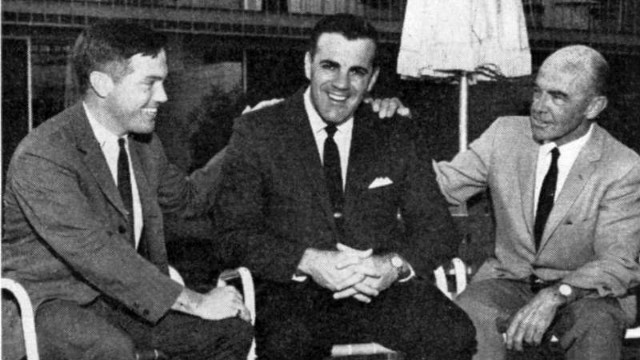
Left to right: James J. Dunnigan Jr., famed Notre Dame football coach Ara Parseghian (center), and James J. Dunnigan Sr pose for a photo. Source: phoenixtrottingpark.com.
Reportedly Miller, who was also an astute businessman, strongly suggested that Dunnigan take a much more conservative approach to introducing harness racing in such an unfamiliar geographical area. His advice was to make a deal with the current thoroughbred track in Phoenix to install lights and race in the evening opposite the runners. It was estimated that this could be accomplished for the modest sum of about one million dollars. This plan apparently did not convince Mr. Dunnigan so he proceeded with his grandiose plan.
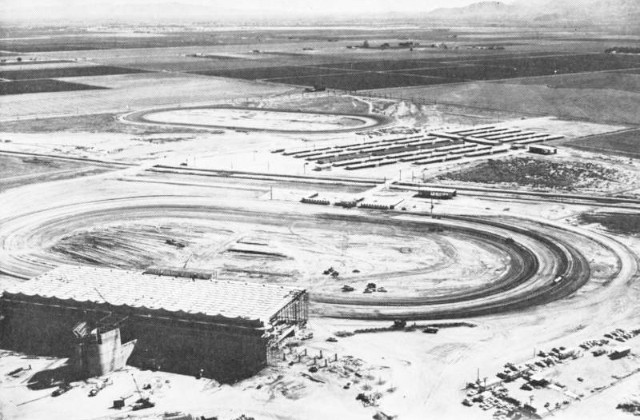
An aerial view of the Phoenix track during construction in 1964. Source: phoenixtrottingpark.com
In 1964 construction of the new track to be known as "The Phoenix Trotting Park" began. It was located in the State of Arizona at a location called Goodyear, about 20 miles from Phoenix on a huge parcel of land covering some 640 acres. The design and architectural details were the work of Impressa Eugenio Grassetto of Padua, Italy. The construction methods, using precast concrete, was considered cutting-edge at the time but became common in the years that followed. Special planning to include every detail to deal with unique weather conditions, location and climate were adhered to from the onset.
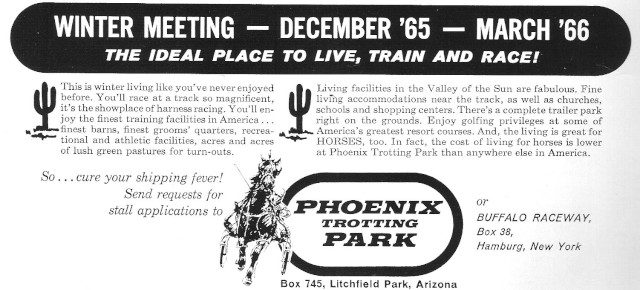
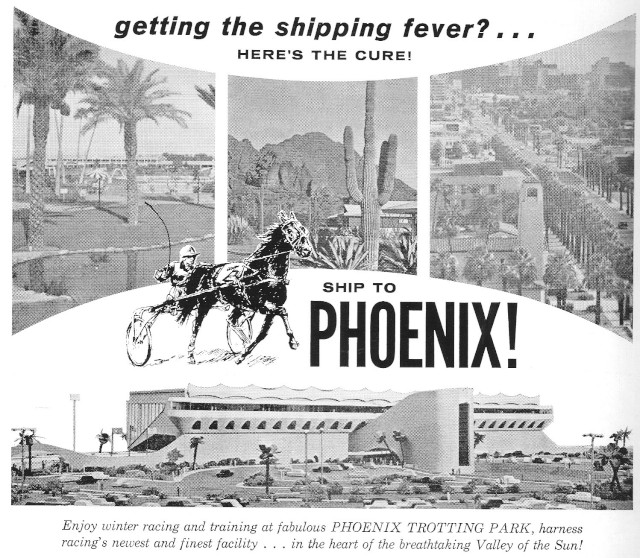
The above ads from Harness Horse magazine in 1965 invited horse people to ship their horses to the new Phoenix Trotting Park described as "harness racing's newest and finest facility."
The original estimate to build and put the new track in operation was initially set at a cost of $2-3 million at most. The facility ended up costing around $10 million. This fact, even assuming the best fortunes of the new venture, had to be regarded as problematic long before the track ever opened. It gave the owners and operators little room to make a profit. Nevertheless it was considered a marvel of construction engineering and was completed in less than a year from groundbreaking to the first race.
Once completed it was truly a beautiful race plant as shown by some of the accompanying photographs. All aspects of the facility were very well done. The fans' needs and comforts were virtually all met and the stabling structures were the very finest. With a grandstand designed to hold 5,400 spectators, it was a sight to behold.

The Trotting Park opened on January 12, 1965 to a crowd of 12,223 attendees. That first night, more than $130,984 was wagered at the gleaming new facility. The park received a great deal of press coverage and was featured in Sports Illustrated magazine and in The New York Times. It was also featured on the cover of Harness Horse magazine and Hoof Beats magazine. Things were off to a great start, but it wasn't long before the park's luck changed.
While the track enjoyed a short period of prosperity, the "honeymoon" phase was short lived and the track soon began to falter. Crowds dwindled and many reasons for the track's imminent failure began to surface. Free parking and other promotions failed to reverse the negative trend. On Thanksgiving Day 1966 a special Turkey dinner with all the trimmings was offered for 97 cents as an incentive to draw fans. It seemed that nothing could save the track.
While the restaurant was air conditioned the rest of the facility was not and this soon limited crowd size and added to the track's woes. This area was fairly undeveloped at the time and lacked proper roads to accommodate visiting fans. Per capita wagering never reached an acceptable level and it seemed that the track drew very few new fans that enjoyed harness racing.
On December 7, 1966 the track closed its doors citing "insufficient public support." In a public apology to the competing horse people Mr. Dunnigan Sr. expressed optimism that the track might open again one day but it never did. Mr. Dunnigan had borrowed heavily against Buffalo Raceway to finance the new track and once it failed he was forced to sell the N.Y.-based track. The colossal building outside Phoenix stood vacant and decaying for decades as a reminder of a failed operation and was really never fully utilized again. It was converted to an equine facility for other types of horses but never standardbreds. The name was changed to Arizona Equestrian Center.
It was also used as the site of a movie in 1998 titled "No Code of Conduct" starring Charlie Sheen. Apparently even then there were unforeseen problems when an explosion near the end of the movie inadvertently killed some pigeons who had taken up residence in the abandoned grandstand. This drew the ire of several animal rights groups and affected the movie's ratings.
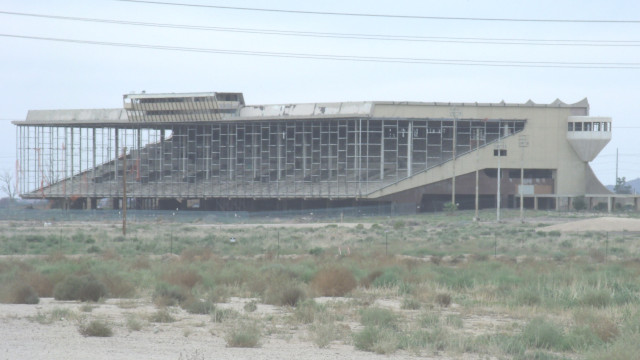
The track stood abandoned for many years and was finally demolished in 2017. The track stood idle for so many years it eventually served as a landmark for the area. Many people gazed at it as passers by, unaware of what it was ever used for.
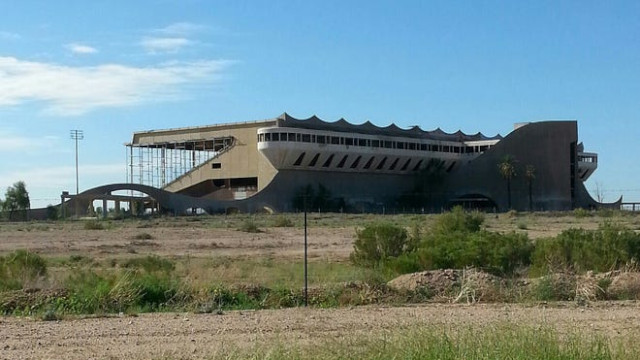
The track's grandstand sat vacant for 50 years after its closure in 1966. A rear view is shown above.
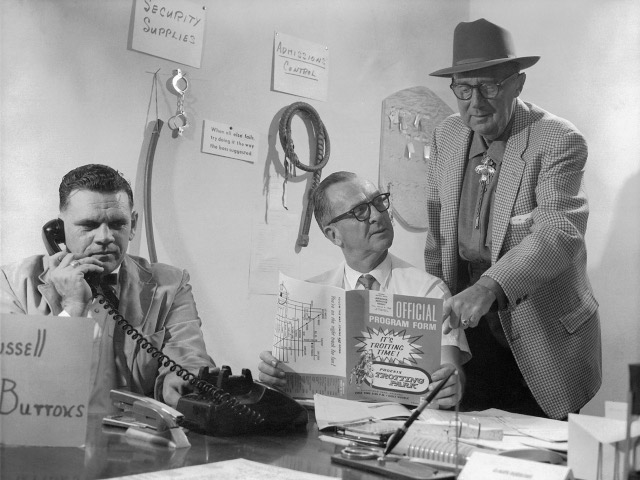
This funny promotional photo for the Trotting Park features a bullwhip used for "Admissions Control" and a sign that says "When all else fails, try doing it the way the boss suggested." Source: phoenixtrottingpark.com.
Closing Note: I have never heard or read too much about the involvement of Canadian horse people at the Phoenix track. One person I have heard about being stabled there was legendary horseman Wilbur Thompson of Weyburn, Sask. There may have been more but I do not know.
The following paragraph describes the career path of Mr. Dunnigan following the failed Phoenix Trotting Park project.
"Undeterred by his failed business venture, Dunnigan moved west to California and set about rebuilding his career. In 1973, Dunnigan was awarded "The Comeback of the Decade" award from the U.S. Harness Writers, for his part in launching the successful harness race meeting at Los Alamitos, Calif and later Golden Bear Raceway. He also received the Grand Circuit Medallion Award in 1971. At various times during his long association with the sport, he served as a director of the USTA, Harness Tracks of America and the Harness Racing Institute. In 1975 he was inducted into the Living Hall of Fame."
James J. Dunnigan died on April 6, 1983 at the age of 71
Quote For The Week: "The world can always use more kindness."
Who Is It?
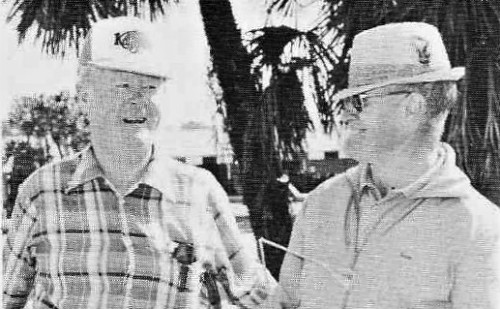
Can you correctly identify these two fellows? I see palm trees in the background. (Photo courtesy of the Standardbred)
Who Else Is It?
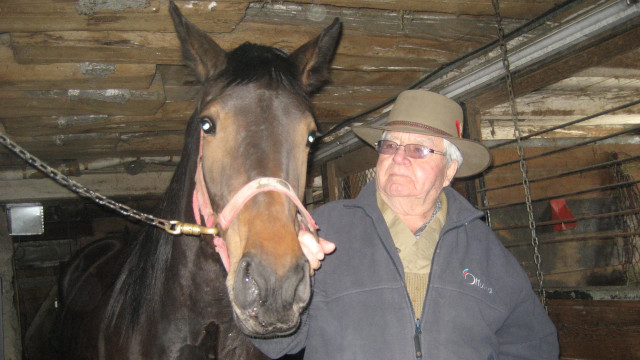
Can you put a name on this gentleman? Clue: He's been around for quite a while.
Southern Training At Its Best
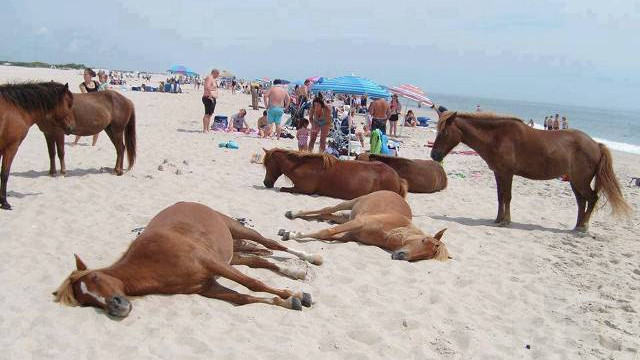
According to recent reports received from an undisclosed Southern location, trainers there have found a new way to rest their horses between starts. The above picture pretty much tells the story and it looks like a fairly good way of life for everybody.
Note - I would encourage everyone to decide for yourself if the above caption is actually true.


This week's picture…
This week's picture identities were as follows :
The correct answer to "Who is it ? was the duo of Jimmy "Red " Holmes on the left and Keith Waples on the right . Both are well remembered by a lot of long time followers of the sport.
Who else is it ? was answered by several as Dr. Roland Montgomery Armitage the pride and joy of Dunrobin Ont. known by all as "Roly" . This photo was taken a few years ago by the late Wm. Galvin during one of his many visits to his Armstead farm and kindly passed along to me .
Thanks to those folks who sent in comments ;your input is appreciated and important .
Thanks folks
Thanks to the people who added the names of those who raced at Phoenix Trotting Park - very interesting . Also, I extend my condolences to Janie Armstrong and her family on the loss of her brother Brent Davies. I believe there was a picture of him in a recent edition of Rewind. Also a note to Gord Remmen : When Ray was starting out at Windsor I got to know him a bit as I believe he drove a horse of my Dad's as a favor for Murray Waples. Readers' input is always appreciated .
Re: your closing notes
I find it ironic that you should post an article about the Phoenix Trotting Park and commenting on the involvement of Canadian horsemen . Just to let you know that my brother Brent Davies who just passed away on February 10th raced at that track. Your article raised questions about the track that I now wish he would be able to comment on.
Thank you to all the people who expressed their condolences. They are greatly appreciated.
Phoenix Trotting Park
Adding to Gord Remmen's comments, there were several Western Canadian horseman that went down to Phoenix including Hall of Famer Keith Clark's father Lorne as well as my grandfather Forest Wilson. My grandfather had noted it was a spectacular 5/8 mile racing surface with miles in 2:04 and 2:05 common place which were unheard of then for those boys that had only raced on half mile tracks out west!
Jimmy Red Holmes, Keith…
Jimmy Red Holmes, Keith Waples (The Master)
Rolly Armitage
Other Canadian horsemen...
My grandfather - Art Hunter- and my brother Ray Remmen made the trip south from Sask. for that one and only race meet. I remember it well as Ray had just graduated from high school and it was very traumatic for my mother!!! After the Phoenix track closed up, Ray and my grandfather moved to Windsor Raceway where Ray spent quite a few years alternating between Western Canada and Windsor. Eventually, he and my brother Larry moved to Meadowlands where they raced until they retired.
The gentleman on the left is…
The gentleman on the left is Jimmy "Red" Holmes, Horses keep Holmes, Holmes keeps horses. I was stabled next him at Batavia in the early 70's. He bought my house trailer . Great guy
who is it Jimmy Red Holmes…
who is it
Jimmy Red Holmes Keith Waples
who else is it
Jay Siverheels
Red Holmes, Bob McNiven,…
Red Holmes, Bob McNiven, Rolly.